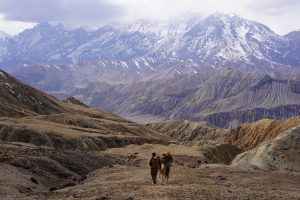In the desolate and seldom visited region of northern Nepal, not far from the Tibetan Plateau, lies the once forbidden kingdom of Mustang. For centuries, only hardy traders and devout pilgrims were allowed to undertake the arduous journey along the trans-Himalayan desert trail that used to be part of a centuries-old salt route between India and Tibet.
Two generations ago, for Jamyang Wangchuk, a local tradesman on the salt route, it took more than 20 days to reach the capital of Kathmandu from the ancient settlement of Lo Manthang. Wangchuk, now 74, recalls leading a caravan of men, women, and horses, following a deep river gorge, ascending through hardwood and conifer forest, weaving through villages made of mud and stone, and emerging into alpine pasturelands north of the Annapurna range.
For centuries, caravans led by traders like Wangchuk tirelessly roamed the Kali Gandaki gorge for weeks, traveling between regions of China, Tibet, and India with yak, salt, wool, cereals, and dried meat, spices, and other goods. They traveled by foot or on horseback along treacherous paths carved by hand into sheer cliffs.
But in the last two decades, a highway has sliced through and opened up Mustang to the outside world. Thanks to the development, almost 40 years later, Wangchuk trudges with ease at 15,000 feet above sea level, and it takes him a single day to travel from Kathmandu to Lo Manthang.
The construction of the road has put the inhabitants of Mustang at the center of a fundamental debate between two competing visions for the future of the entire region.
*****
Mustang’s local Lo people trace their lineage to neighboring Tibet, and for centuries have herded yak and tended fields in what they view as a sacred landscape. But after opening its doors to outsiders in 1992, the region garnered the interest of the outside world, becoming one of the most sought after trekking destinations in the remote Himalayas.
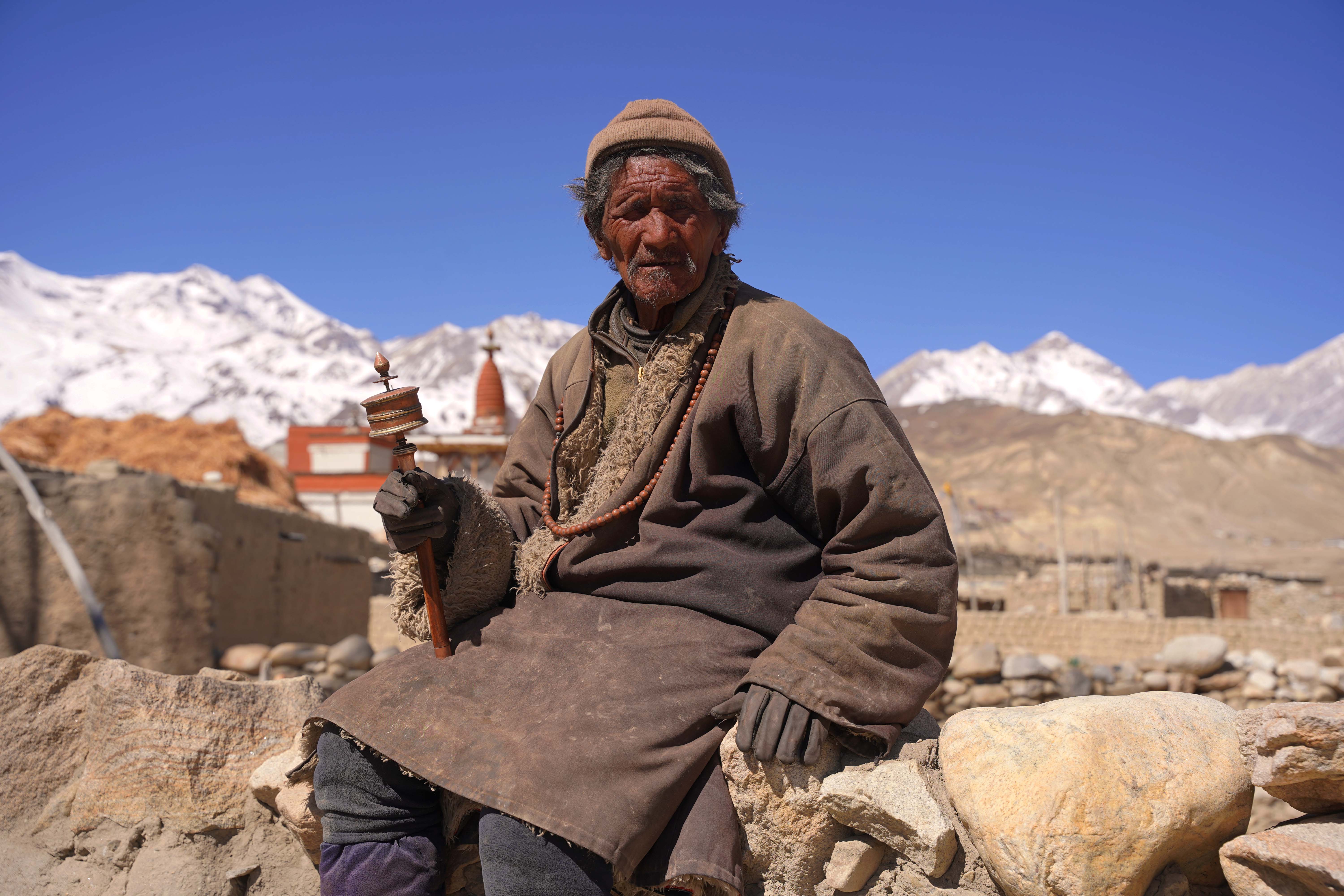
Jamyang Churidar sits atop a stone wall in the village of Lo Manthang, spinning a hand-held prayer wheel. Lo Manthang, a centuries-old town in Upper Mustang, has been radically changed by the advent of paved roads. Photo by Tulsi Rauniyar.
The motorable road that connects Lo Manthang to Jomsom and further extends to the Chinese border at Korala has made the region one of the most accessible corridors of the Himalayas. Now, there are Western explorers, domestic tourists driving motorcycles and sturdy four-wheel drives, and all the other travelers who flock to the former seat of the Tibetan kingdom for festivals and a taste of Buddhist culture close to the Chinese border.
“Tourism gave us a source of income, not just trek leaders and Sherpas, but cooks, teahouse operators, and shopkeepers,” says Dara Gurung, the president of Muktinath village municipality in Mustang, who also owns a hotel in Kagbeni. “Tourism has transformed the face of Mustang.”
Besides improved accessibility, the arrival of roads has improved access to health facilities and brought modern day-to-day necessities that were nearly non-existent a decade ago.
“We had to walk for days to reach the nearest health post. Many died on the way while most turned to traditional healers due to the lack of knowledge or access to health care,” says Dara. He told the story of his aunt, who had a difficult childbirth, resulting in her infant’s death. If the road had been finished, he said, perhaps she could have reached a hospital in time to save the baby.
Villagers of Lo Manthang, popularly known as Lobas, say now they can afford to buy necessary goods, and the cost of transporting consumer items from Pokhara by truck is far cheaper than via porters or horses.
Many Lobas favor the road, saying it is an essential bridge to the modern world, sorely needed in this remote region. “Times have changed. Life is much easier now that the roads are here,” notes another local inhabitant.
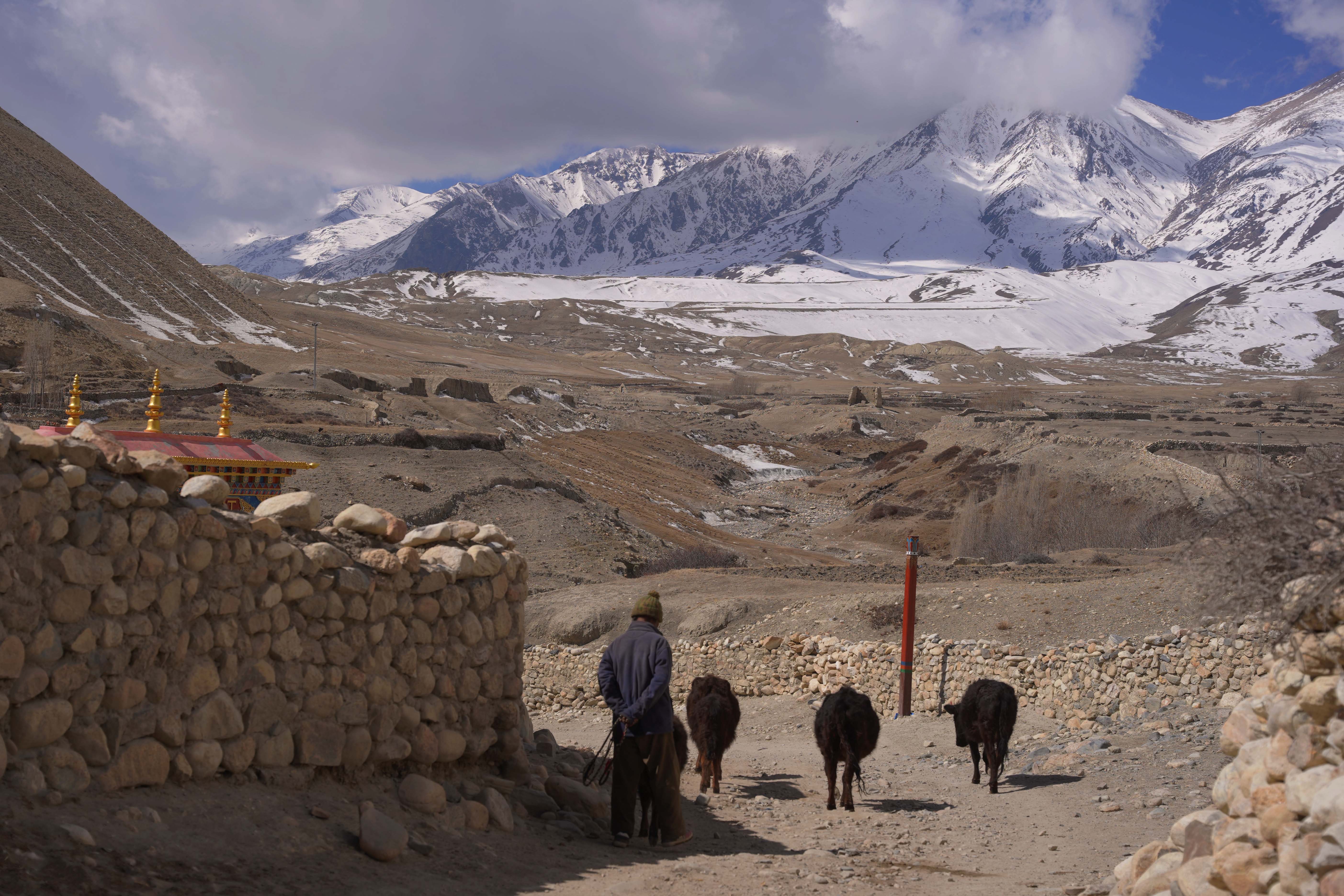
Churidar walks his livestock to the nearest river stream along the newly built road that runs through the ancient village of Lo Manthang and connects it to China to the north. Photo by Tulsi Rauniyar.
Of course, the economic incentives for driving roads into the remote wilderness are strong. Governments see roads as a cost-effective means of boosting economic development and accessing natural resources, but the benefits have paled in comparison to the indirect impact on the local culture.
While most of Tibetan Buddhism is strangulated inside China’s borders, Upper Mustang is one of the few places where the remnants of ancient Tibetan culture are still thriving and the local people have been generally successful in preserving the tradition.
But there are concerns that the development of roads is threatening the region’s traditional way of life, and its dwindling ancient indigenous cultures.
“With modernity seeping into the region, the practice of our culture is being hampered. After the roads, many have adopted modern ways of dressing, cooking, and worshiping entirely. That is fueling culture erosion,” says Chime Rinzin, a head monk at a monastery in Lo Manthang.
Rinzen says the numbers of monks are also declining, and that practicing Tibetan Buddhism has become more difficult. Many of these villagers are leaving to seek jobs and education in cities and abroad, as they now have economic incentives from tourism. They are being replaced by new arrivals and temporary workers who have little interest in cultural preservation.
The benefits of unique culture for tourism can’t be overstated, says Bruce Moore, the program director of the American Himalayan Foundation (AHF) a U.S.-based non-profit that helps preserve Himalayan culture. Travelers come to Mustang to witness its unique religion. If there is no culture, there will be no tourism.
Mustang is already paying another hefty cost when it comes to trekking tourism. As motor vehicles now run on what used to be a famed trekking route, the interest among visitors to trek through the valley has diminished.
“Before the roads came in, tourists trekked for 12 days, from Jomsom to Muktinath and further up to Lo Manathang,” says Dara. “Now with the roads, more people are driving straight to Lo Manthang from Jomsom and driving out the next day. This has deprived local lodge owners, restaurants, and even tourism workers of their livelihoods.
*****
In other cases, there are concerns that roads carved from the mountains with bulldozers will have detrimental effects on the region’s pristine ecology.
The trans-Himalayan region boasts immense biodiversity, which includes several threatened species and supports local livelihoods. As is always the case, the construction of an extensive road system spells the beginning of the end of these wild areas, with roads opening the way for illegal deforestation, poaching, wildfires, and investors bent on developing logging and hydropower projects.
Meanwhile, as roads pierce through the pristine landscape, expelling chemical and nutrient pollutants, many exotic species are placed at risk. These include traditional wild yak caravan systems, rare medicinal herbs, endangered snow leopards, and iconic Himalayan brown bears.
Besides, experts say, the cut-and-fill operations associated with road construction can already be seen impeding the Kaligandaki gorge, one of the world’s deepest, that cuts through the landscape, and has drastically accelerated soil erosion.
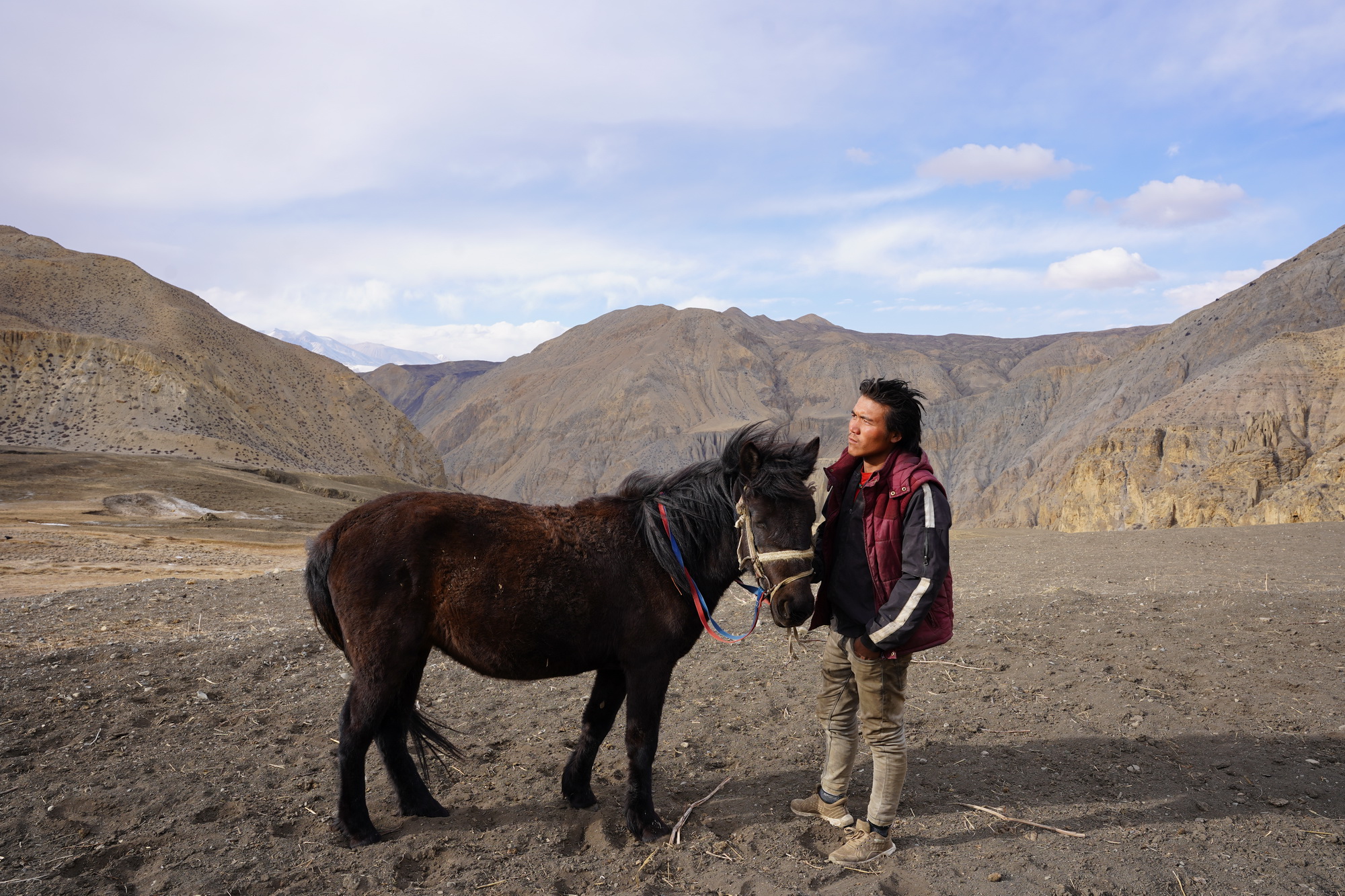
Pasang Tashi is the only young man in his village of Dhye in Upper Mustang. He says eventually he plans to migrate to the capital of Kathmandu too. Out-migration of youths is common in the region, with many leaving for improved educational opportunities and economic prospects. Photo by Tulsi Rauniyar.
In practice, preventing these environmental impacts on roads in Nepal is expensive and risky. Nepal barely has the institutional capacity or financial resources to adequately manage development in the remote frontier regions like Mustang, let alone to pay the premiums necessary to ameliorate the negative impacts of infrastructure projects.
For now, the change appears too big and too quick for Mustang to handle. Dipak Gyawali, a political economist and former Nepali water resources minister, says, “Even to minimize the damage and ensure some level of safety, you have to take into account the environment, geology, geography, vegetation, and the impact on human settlements before undertaking a project like this and tearing through the mountains.”
But there is little oversight by either the local or national governments. According to Nepali law, every infrastructure project must be accompanied an Environmental Impact Assessment (EIA). Every local authority The Diplomat talked to said none of the new improvised roads here has involved proper EIAs.
*****
At present, numerous road projects are converging simultaneously on the narrow, once-isolated valley of Mustang. These projects are part of an ambitious new goal in Nepal to construct paved, gravel, or dirt roads to every town and rural settlement in the country. Few countries can match Nepal for the sheer pace and scale of road expansion. More roads have been built in Nepal in the past decade than in the last 50 years. In 2017, Nepal imported the highest number of backhoe loaders and excavators ever purchased by any country in South Asia.
As this frenzy of road construction bites into even the most desolate valleys of the Himalayas, woeful farmers and traders who have been long neglected by Nepal’s government are hoping that the roads will bring new jobs, lower trade and transportation costs, and improved access to health care and education in the far-flung corners of the country.
But this road-building frenzy is going to have serious repercussions, says Gyawali. Much of this destructive, mechanized road-building doesn’t create sustainable jobs or opportunities, but rather opens up the hinterland to exploitation by outside interests. It is vital that decisions to balance development with conservation of nature and culture be taken now.
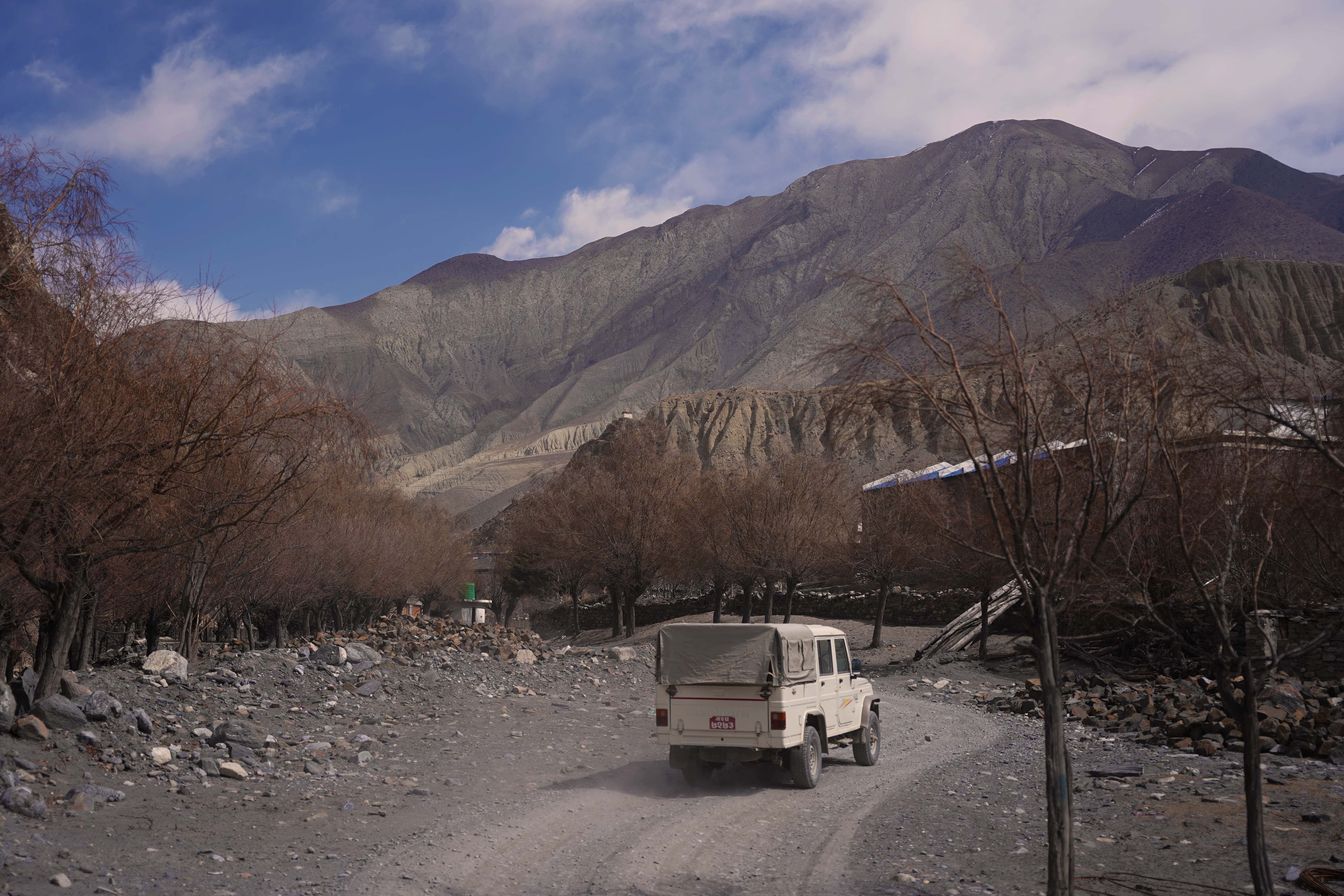
A four-wheel-drive drives through the village of Kagbeni in lower Mustang, leaving a trail of dust behind. Some locals claim that the smog from trucks and buses and the throb of internal combustion engines has marred the pristine ecology of the region. Photo by Tulsi Rauniyar.
And alternatives do exist, says Gyawali. “Ropeways or long-haul electricity-powered cable cars can reduce the overall financial and environmental cost of the development of transportation in the country while also being nicely in tune with Nepal’s growing hydropower capacity. As one can also see, roads in Mustang appear like ugly gashes, but ropeways would not have marred the natural beauty.”
For instance, a cargo-only ropeway is now being proposed right at the footfall of Mount Everest, on the trekking route from Lukla to Namche Bazaar. Stakeholders are saying this should reduce the increasing reliance on the near-endless mule trains to transport supplies while preserving the region’s fragile ecology.
Not only this, ropeways could well save lives. Bus plunges and other vehicle accidents occur routinely in Mustang. Nepal recorded five deaths a day on average due to road accidents in the first three and a half months of a recent fiscal year.
But ironically, ropeways have remained Nepali transport planners’ blind spot, despite their palpable advantages in the context of the country’s economy and topography.
Nepal is in a hurry to create roads, says Gyawali. But aside from reducing transport time for some goods, there have been no studies that verify the exact economic benefit of roads, let alone how these gains are distributed. So we have no way of assessing whether the benefits are worth the environmental and social costs.
Amidst the road-building frenzy, never seen before in the country, road construction in Mustang has created a conundrum, of what should be forced to change and what should be left unscathed. This conflict is emblematic of the complex choices over rural development now confronting much of the Himalayas.
While many planners turn a blind eye to environmental and cultural impacts of infrastructure development, for some, it is a subject of visceral dissatisfaction. When Wangchuk of Lo Manthang sees his roadside home coated in dust from trucks wheeling by, he despairs at the pace of change that is engulfing his village.
“Is this what is meant by development? Who is making the decisions for us people from the corners?” he says. “Our future looks uncertain.”













